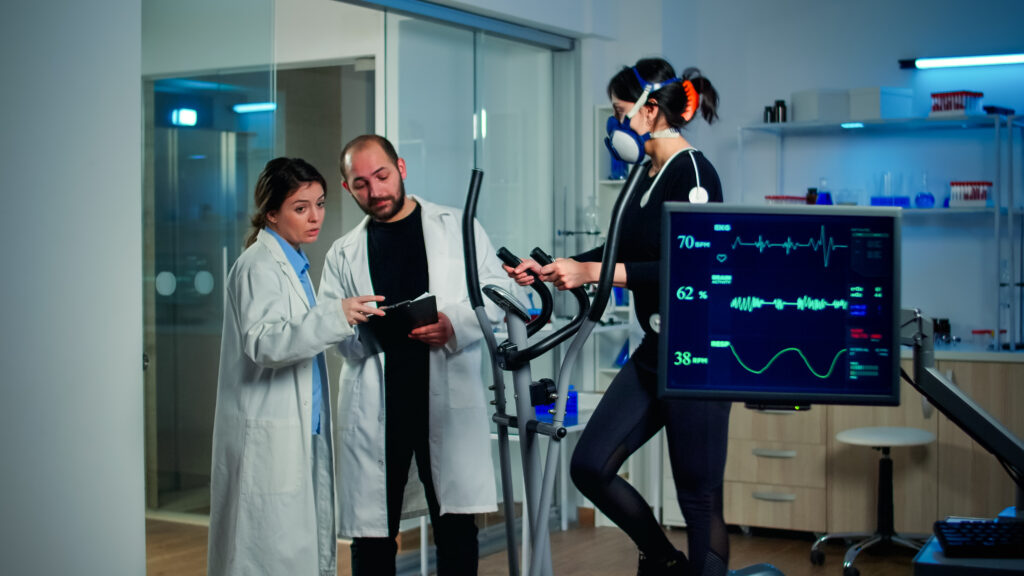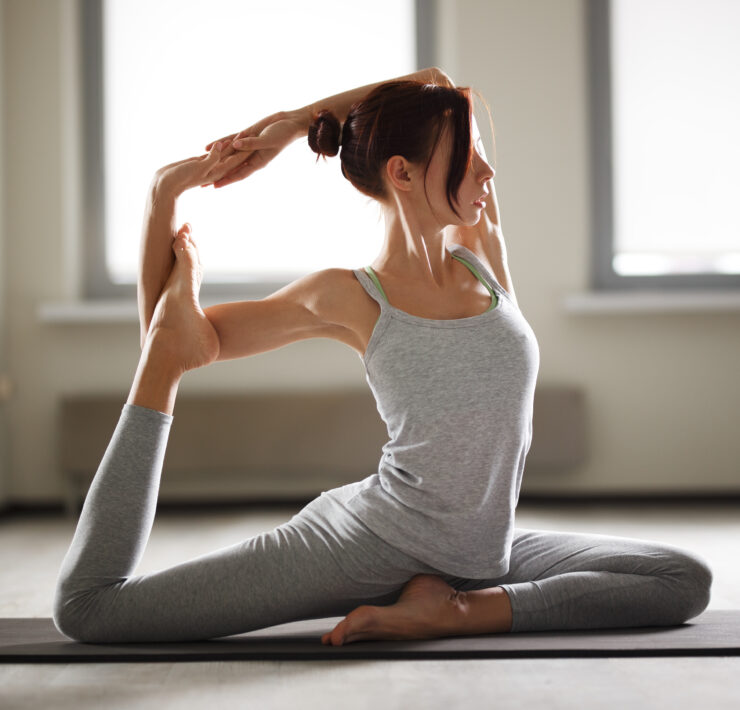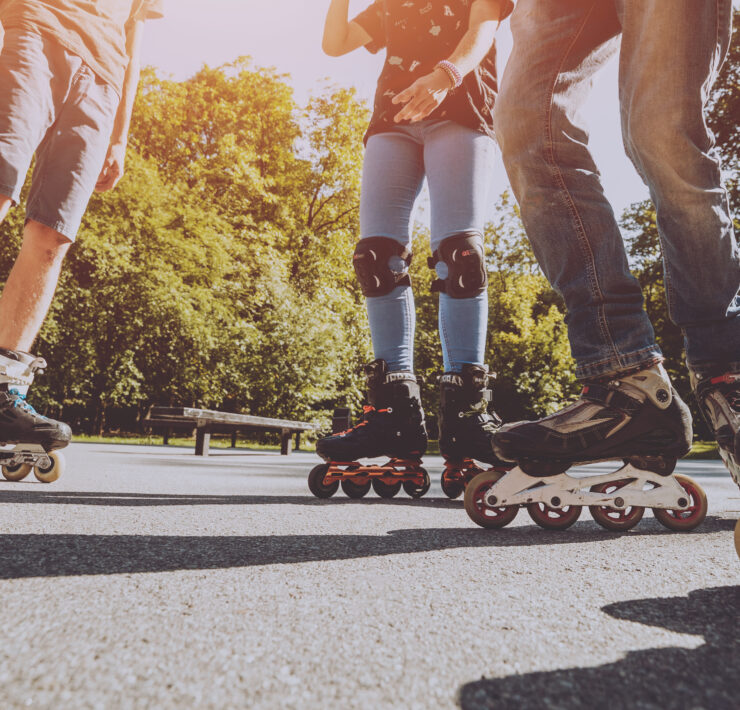What is Your Biological Age? VO2 Max Reveals It

Can a 50-Year-Old Match the Fitness of a 20-Year-Old? Yes, Thanks to VO2max! Imagine being a lifelong athlete, deeply immersed in the world of sports, and then stumbling upon a term that could hold the key to unlocking your full potential. That’s precisely what happened to me (former college athlete) and I’ve always lived a life deeply immersed in body movement and sports.
Until recently, the concept of “VO2 max” was not a part of my athletic vocabulary. But when I discovered it, I was floored by its significance in the realm of fitness and sports, and more importantly, its potential impact on longevity and cardiovascular health. VO2 max, or maximal oxygen uptake, is not just a scientific term; it’s a powerful measurement that can redefine your approach to well-being.
Intrigued by its potential, my team at Breathe Miami recently hosted a padel event where we introduced VO2 testing to our guests. The response was nothing short of incredible. It opened doors to a world of possibilities and opportunities to optimize our fitness journeys and enhance our overall health.
In this article, we’ll embark on a journey to explore what VO2 max truly is, how it’s measured, and why it has become a focal point for athletes, fitness enthusiasts, and wellness seekers like myself.
What is VO2 Max?
VO2 max, or maximal oxygen uptake, is a vital physiological measurement that plays a central role in understanding an individual’s cardiovascular fitness and aerobic capacity. At its core, VO2 max represents the maximum amount of oxygen your body can effectively utilize during intense exercise. It’s often considered the gold standard for assessing aerobic fitness and endurance.
The Significance of Oxygen in Energy Production
To comprehend the significance of VO2 max, it’s essential to recognize the critical role oxygen plays in energy production, particularly during aerobic activities. When we engage in exercises like running, cycling, or swimming, our muscles require a constant supply of oxygen to generate the energy needed to sustain physical effort.
Here’s how it works:
- Oxygen Delivery: During aerobic exercise, your heart pumps oxygen-rich blood to your working muscles. This oxygen is transported via the bloodstream to the muscle cells that are actively involved in the exercise.
- Energy Production: Within these muscle cells, oxygen is used in a process known as aerobic respiration. During this process, carbohydrates and fats are broken down in the presence of oxygen to produce adenosine triphosphate (ATP), the primary energy currency of the body.
- Efficiency Matters: The more efficiently your body can deliver oxygen to your muscles and utilize it to generate ATP, the better you can perform during aerobic activities. In essence, your aerobic capacity, as reflected by your VO2 max, measures how effectively you can use oxygen to produce energy.
A higher VO2 max indicates that your cardiovascular system can deliver more oxygen to your muscles, allowing you to work at higher intensities for longer durations. This not only improves your athletic performance but also enhances your overall endurance and stamina.
The Physiology of VO2 Max:
Now that we understand the basics of what VO2 max is, let’s delve deeper into the physiology behind this intriguing concept. As we discussed earlier, VO2 max represents the maximum amount of oxygen your body can utilize during intense exercise. But why is this measurement so significant, and what role does oxygen play in energy production during aerobic activities?
To appreciate the importance of VO2 max, it’s essential to grasp the fundamental role of oxygen in our bodies. Oxygen serves as the key ingredient in the process of energy production, particularly during aerobic activities. When we engage in exercises like running, cycling, or swimming, our muscles require a steady supply of oxygen to convert carbohydrates and fats into the energy needed to sustain physical effort.
Here’s how it works: During aerobic exercise, your heart pumps oxygen-rich blood to your muscles. The oxygen is then utilized by the mitochondria, often referred to as the “powerhouses” of the cell, to generate adenosine triphosphate (ATP), which is the primary currency of energy in our bodies. The more efficiently your body can deliver and use oxygen, the better it can produce ATP, allowing you to perform at higher intensities and for more extended periods.
This is where VO2 max comes into play. It measures the upper limit of your body’s ability to transport and use oxygen during exercise. In essence, it quantifies your body’s efficiency in the energy production process during aerobic activities. A higher VO2 max indicates that your cardiovascular system can deliver more oxygen to your muscles, allowing you to work harder and longer.
As athletes, fitness enthusiasts, and wellness seekers, understanding the physiology of VO2 max can be a game-changer. It empowers us to optimize our training routines, push our limits, and ultimately improve our cardiovascular fitness and endurance. In the next section, we will explore how VO2 max is measured and its practical implications for our health and performance.
Measuring VO2 Max: Methods and Considerations
At Breathe Miami, we’re all about putting theory into practice, and that’s precisely what we did during a recent Padel tournament. We introduced VO2 max testing to our guests, transforming it from an abstract concept into a tangible, personalized experience.
Here’s how it worked:
- Resting Breath Analysis: Participants took a quick 10-minute resting breath analysis, offering insights into their oxygen utilization efficiency.
- Swift Results: Within 24 hours, participants received their VO2 max data, transforming numbers into actionable information.
- Personalized Coaching: Each participant was paired with a coach who analyzed their results and provided tailored recommendations for improving their VO2 max.
There are various methods for assessing VO2 max, ranging from laboratory-based tests to field tests, each with its own set of advantages and limitations.
1. Laboratory Tests:

a. Treadmill Test:
- Pros: Treadmill tests conducted in a controlled lab environment allow for precise measurement of VO2 max. The treadmill’s adjustable speed and incline provide a controlled means of increasing exercise intensity until exhaustion.
- Cons: This method requires specialized equipment and trained personnel. It may not be suitable for individuals with mobility issues or those uncomfortable with treadmill running.
b. Stationary Bike Test:
- Pros: Stationary bike tests offer an alternative to treadmill testing, making it suitable for individuals with joint or mobility concerns. It provides accurate results and can be adjusted to increase exercise intensity gradually.
- Cons: Similar to treadmill testing, it requires access to specific equipment and expertise. Some individuals may find stationary cycling less familiar or less enjoyable than running.
2. Field Tests:
a. Cooper Test:
- Pros: The Cooper test is a straightforward and widely used field test that involves running as far as possible in 12 minutes. It doesn’t require specialized equipment and can be performed almost anywhere.
- Cons: While it provides a rough estimate of VO2 max, it may not be as accurate as lab-based tests. It also relies heavily on an individual’s running speed, which can vary.
b. Rockport Walk Test:
- Pros: This field test is suitable for individuals who are not comfortable with running. It involves brisk walking for one mile, with heart rate measurements. It’s accessible and straightforward.
- Cons: Like the Cooper test, it offers an estimate rather than a precise measurement of VO2 max.
c. Field-Based Cycling Tests:
- Pros: There are various field-based cycling tests, such as the 1.5-mile cycling test, that offer a less strenuous alternative to running-based tests.
- Cons: These tests may still require some specialized equipment, like a bicycle, and may not be as widely used or validated as running-based field tests.
d. Smartphone Apps and Wearables:
- Pros: With the advancement of technology, there are smartphone apps and wearables that claim to estimate VO2 max based on heart rate and performance data.
- Cons: The accuracy of these consumer-grade devices can vary, and they may not be as precise as laboratory testing.
Apple Watch 3 Series or Later
So how does the Apple Watch figure this out? It uses the sensors to monitor your heart rate while you’re pounding the pavement or hitting the trails during an Outdoor Walk, Run, or Hike. It needs a few workouts to get a good read, so it’s not an instant know-how.
The Apple Watch is pretty on point. Apple claims it’s has an error margin of less than 1 MET and an ICC of over 0.85, which means it’s pretty reliable compared to traditional submaximal tests.
But, and there’s always a but, it’s not perfect. Like most tech, it can overestimate your VO2 max, similar to what we’ve seen with other fitness wearables. So, if you’re an elite athlete pushing the boundaries, the Apple Watch might not keep up with your progress past a certain point.
Want to make sure your Apple Watch is giving you the best data? Keep it snug on your wrist during workouts, pause it when you’re not moving, and keep your personal info up to date. Oh, and recalibrate the thing now and then.
Remember, while the exact number might be a bit off, what really matters is the trend. Seeing your VO2 max improve over time is the real win here. It’s a solid way to keep an eye on your fitness progress, even if it’s not lab-grade.
The choice of method for measuring VO2 max depends on factors such as accessibility, equipment availability, individual preferences, and the level of accuracy required. Laboratory-based tests offer the highest precision but are often less accessible and may be intimidating for some individuals. Field tests provide a more practical option for many people, although they provide estimates rather than exact measurements. Additionally, it’s essential to consider that individual variability, such as fitness level and motivation, can impact test results, regardless of the chosen method. Regardless of the method used, regular VO2 max assessments can be a valuable tool for tracking your fitness progress and optimizing your training regimen.
The Role of VO2 Max in Fitness and Health
Understanding your VO2 max goes beyond the realm of numbers; it’s a powerful indicator of your cardiovascular fitness and an essential component of your overall health. Let’s explore how VO2 max serves as a valuable metric in assessing your fitness level and its pivotal role in preventing chronic diseases like heart disease and diabetes.
Indicator of Cardiovascular Fitness:
VO2 max is often hailed as one of the most reliable indicators of cardiovascular fitness. It quantifies your body’s ability to transport and utilize oxygen during intense exercise, which directly correlates with the efficiency of your cardiovascular system. The higher your Vo2 max, the better your cardiovascular fitness. Here’s how it works:
- Efficient Oxygen Delivery: A high VO2 max signifies that your heart can efficiently pump oxygen-rich blood to your working muscles during exercise. This ensures that your muscles receive the necessary oxygen to produce energy, allowing you to perform at higher intensities and for longer durations.
- Enhanced Endurance: Individuals with a higher VO2 max can sustain physical effort for extended periods without fatigue. This endurance is a testament to a well-conditioned cardiovascular system, making it a crucial metric for athletes and fitness enthusiasts aiming to push their limits.
Overall Health and Chronic Disease Prevention:
Beyond its significance in fitness, VO2 max plays a crucial role in safeguarding your overall health. It serves as a proactive shield against chronic diseases, including heart disease and diabetes:
- Heart Disease Prevention: A strong correlation exists between low VO2 max levels and an increased risk of heart disease. Regular aerobic exercise that improves VO2 max contributes to a healthier heart by reducing factors like high blood pressure, cholesterol levels, and excess body fat.
- Diabetes Management and Prevention: VO2 max is linked to improved insulin sensitivity. Higher levels of VO2 max help regulate blood sugar levels, making it an essential component in the management and prevention of type 2 diabetes.
VO2 max is a holistic measure that reflects not only your fitness level but also your overall health. By working to improve your VO2 max through consistent exercise and a healthy lifestyle, you’re not only enhancing your physical performance but also fortifying your body against the onset of chronic diseases. It’s a compelling reminder that investing in your cardiovascular fitness is an investment in a healthier and happier life.
What Is Your Fitness Age?
As the years go by, our bodies undergo various changes, and one area where this is particularly evident is in our cardiovascular fitness, as measured by VO2 max. Typically, VO2 max tends to peak during our 20s, after which it gradually starts to decline, diminishing by approximately 10 percent per decade.
However, the exciting news is that you can actually slow down this decline and even reverse the clock on your cardiovascular fitness. It’s all about understanding and harnessing the power of your VO2 max.
The formula for boosting your VO2 max is refreshingly straightforward: engage in aerobic exercise. Consistent aerobic activity enhances your VO2 max, while a sedentary lifestyle can lead to a decline in cardiorespiratory fitness.
But here’s where it gets intriguing: you can gain a deeper understanding of your fitness by comparing your current VO2 max to data from others in your age group. This is where the concept of “fitness age” comes into play.
What is Fitness Age?
Imagine this: Your VO2 max is compared to the average VO2 max of people in different age groups – younger, older, and the same age as you. This comparison allows us to determine your fitness age.
- If your VO2 max falls below the average for your age group, your fitness age might be older than your actual age.
- Conversely, if your aerobic endurance is excellent, you could have a fitness age that’s much younger than the number on your driver’s license.
Here’s an example: A 30-year-old might have a fitness age anywhere from 20 to 79, depending on their VO2 max.
Let’s say a woman’s VO2 max is measured at 35 ml/kg/min. If the average VO2 max for a 43-year-old woman is also 35 ml/kg/min, her fitness age would be 43. However, it’s crucial to remember that this fitness age can convey a different message, whether her actual age is 25 or 60.
Training to Improve VO2 Max
Improving your VO2 max is an exciting journey that involves a combination of effective training strategies, dedication, and smart planning. In this section, we’ll explore some key training methods that can help you boost your VO2 max and, subsequently, your cardiovascular fitness.
1. High-Intensity Interval Training (HIIT):
- The Power of Intervals: HIIT is a training method that alternates between short bursts of high-intensity exercise and brief periods of rest or low-intensity recovery. It’s a potent tool for VO2 max improvement.
- How it Works: HIIT challenges your cardiovascular system by pushing you to work at or near your maximum capacity during intense intervals. This stress on your body prompts adaptations, including increased VO2 max.
- Sample Workout: An example HIIT session for runners might involve sprinting for 30 seconds followed by a 60-second jog or walk, repeated for several cycles.
2. Endurance Training:
- Building the Foundation: Endurance training involves sustained, moderate-intensity exercise over an extended period. It lays the foundation for VO2 max improvement by enhancing your cardiovascular system’s efficiency.
- Long, Steady Efforts: Activities like long-distance running, cycling, or swimming at a steady pace for an extended duration help condition your body for efficient oxygen utilization.
- Incremental Progress: Gradually increasing the duration and intensity of your endurance workouts can stimulate VO2 max gains.
3. Cross-Training:
- Variety is Key: Cross-training involves engaging in a variety of aerobic activities to prevent overuse injuries, promote overall fitness, and challenge your cardiovascular system in different ways.
- Example: Combining activities like swimming, cycling, and running in your training routine can work for different muscle groups and improve VO2 max by offering diverse stimuli to your body.
The Importance of Progressive Overload and Recovery:
- Progressive Overload: To enhance VO2 max, it’s vital to progressively challenge your cardiovascular system. This means increasing the intensity, duration, or frequency of your workouts over time.
- Structured Training Plans: Consider working with a fitness professional or following a well-structured training program to ensure you are applying progressive overload safely and effectively.
- Recovery: Adequate recovery is equally crucial. Your body adapts and improves during rest periods. Overtraining can lead to fatigue and hinder VO2 max gains.
- Balancing Act: Strike a balance between challenging workouts and sufficient recovery. Listen to your body, and allow it the time it needs to repair and adapt.
VO2 Max in Sports Performance: Unlocking Your Athletic Potential
As we’ve already explored, VO2 max stands as a crucial factor in athletic performance, influencing various sports in profound ways.
1. Running:
- Optimize Endurance: For runners, enhancing VO2 max is often synonymous with improving endurance. To reach your full potential, consider incorporating high-intensity interval training (HIIT) and long-distance runs into your regimen. These workouts can help maximize your oxygen utilization, boost stamina, and elevate your performance.
- Learn from the Best: Take inspiration from legendary runners like Haile Gebrselassie, whose remarkable VO2 max propelled him to world records and numerous victories.
2. Cycling:
- Ride to Victory: Cyclists looking to excel should focus on building both aerobic and anaerobic capacities. Integrate hill climbs, time trials, and sprint intervals into your training. These efforts can elevate your VO2 max and power output, giving you an edge in various cycling disciplines.
- Champions to Emulate: Eddy Merckx and Miguel Indurain are legendary cyclists known for their extraordinary VO2 max levels.
3. Swimming:
- Master the Pool: Swimmers can enhance their VO2 max by incorporating interval training, open-water swims, and technique drills into their routine. These workouts improve oxygen delivery and endurance, helping you perform at your best.
- Learn from Legends: Michael Phelps, with his high VO2 max, demonstrated the impact of superior aerobic capacity in the pool.
4. Team Sports:
- Elevate Your Game: In team sports, including soccer and basketball, VO2 max can set you apart. Train for short bursts of high-intensity efforts, combine them with recovery drills, and focus on agility. Elevating your VO2 max aids in quicker recovery between plays and superior overall performance.
- Emulate the Greats: Cristiano Ronaldo’s incredible athleticism and VO2 max levels have inspired countless athletes in team sports.
5. Rowing:
- Master the Ergometer: Rowers can boost their VO2 max by integrating long-distance rowing, strength training, and interval sessions into their workouts. Achieving an exceptional VO2 max is crucial for maintaining consistent power output and success in rowing.
- Follow in Their Wake: Sir Steve Redgrave‘s five Olympic gold medals were a testament to his impressive VO2 max.
As high-performing athletes, you’re well aware that VO2 max can be a game-changer in your respective sports. By tailoring your training, nutrition, and recovery strategies to maximize your oxygen utilization, you can unlock your full athletic potential. Take inspiration from the legendary athletes who have harnessed the power of Vo2 max to achieve greatness, and use their achievements as motivation to reach new heights in your sporting endeavors.
Conclusion: Unleash Your VO2 Max Potential
In the world of fitness and athletics, understanding your VO2 max can be the key to unlocking your full potential. This vital measurement reflects your body’s ability to use oxygen efficiently during intense exercise, impacting your endurance, performance, and overall well-being.
We’ve witnessed how elite athletes with exceptional VO2 max levels have achieved greatness, serving as a testament to the importance of optimizing this crucial metric. But VO2 max isn’t just for the pros. Thanks to advancements in technology and wellness, you too can explore your Vo2 max and embark on a journey to elevate your fitness age and enhance your cardiovascular health.
The Breathe Miami team is now offering VO2 max testing at a variety of experiences throughout the city each week. It’s an opportunity for you to take a step toward a healthier, more vibrant you. By understanding your VO2 max and working on improving it, you can redefine your fitness journey and transform your well-being.
Ready to discover your VO2 max and unleash your athletic potential? Sign up for testing with Breathe today and embark on a path to a healthier, happier, and more active lifestyle. Your journey to a better you begins now!







